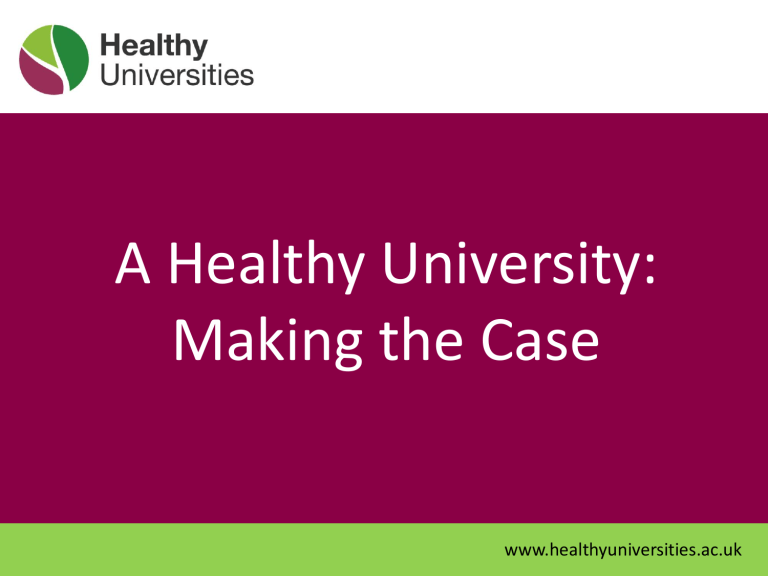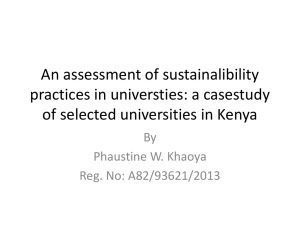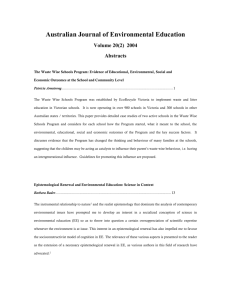Making the Case - Healthy Universities

A Healthy University:
Making the Case
www.healthyuniversities.ac.uk
The Healthy Settings Approach
Homes
Criminal
Workplaces
Schools
Justice
Hospitals &
Universities
Cities
Leisure, Sport &
FE Colleges
Healthcare
Nurseries
Nightlife
Recreation
Prisons &
Markets
“In the settings approach efforts are concentrated on working to make the setting itself a healthier place for people to live, work and play…The settings approach means combining healthy policies, in a healthy environment with complementary education programmes and initiatives.”
Health Promotion Strategy for Ireland (DHC, 2000) www.healthyuniversities.ac.uk
Learning and Health
The healthier you are the more likely you are to be able to learn
Beneficial
Relationship
The more educated you are the more likely you are to be healthy www.healthyuniversities.ac.uk
University Context
• More than 2.3 million students and 370,000 staff in 169 UK higher education institutions (Universities UK, 2008; HESA,
2009) – enormous potential to promote public health.
• Historically, universities have served as settings for the delivery of specific projects on various priority issues, such as drugs, alcohol and mental health.
• Growing focus on staff well-being, reflecting strengthened policy focus on workplace health.
• Increasing interest in moving beyond single topic focus to develop more holistic and strategic ‘whole university’ approach – reflecting success of other settings initiatives
(eg Healthy Schools , Healthy FE). www.healthyuniversities.ac.uk
University Context cont’d
• Review of evidence relating to schools supports a whole school approach, suggesting that effective programmes are
“likely to be complex, multifactorial and involve activity in more than one domain.” (Stewart-Brown, 2006: 17)
• A review focused on further education has concluded that:
“while it is not possible to state with certainty that multicomponent, whole-settings approaches are more successful in college and university settings than one-off activities, the evidence points in this direction” (Warwick et al, 2008: 27).
• This thinking is further reinforced by the Foresight Report on
Obesity, which concludes that:
“the complexity and interrelationships …make a compelling case for the futility of isolated initiatives” (Butland et al, 2007: 10).
www.healthyuniversities.ac.uk
Supporting Strategic Plans
Healthy Universities represents a cross-cutting and multifaceted approach, working with staff, students and the wider community, and developing a range of activities tailor-made for your university that support key deliverables such as:
• Recruitment and Retention
• Student Experience Strategies
• Learning and Teaching Strategies
• Human Resource Strategies
• Sustainable Development
• Corporate Social Responsibility .
www.healthyuniversities.ac.uk
University Policy and
Context Drivers
UUK Guidance
• Reducing Risk of Student Suicide
• Meningitis Guidelines
HE Partnership for Sustainability
• Travel Planning for Sustainability, Guidance for HE
HEFCE
• HE Sector and the 2012 Olympic Games
UCEA
• Preventing and Tackling Stress at Work, An Approach for HE www.healthyuniversities.ac.uk
Developing University Strengths
Healthy Universities means adopting a whole system perspective that takes account of the role of universities as:
• centres of learning and development, with roles in education, research, capacity and capability building and knowledge exchange
• foci for creativity and innovation, developing knowledge and understanding within and across disciplines and applying them to the benefit of society
• places where students undergo life transition – exploring and experimenting, developing independence and lifeskills, and facing particular health challenges
• workplaces and businesses, concerned with performance and productivity within a competitive marketplace
• contexts that ‘future shape’ students and staff as they clarify values, grow intellectually and develops capabilities that can enhance current and future citizenship within families, communities, workplaces and society as a whole
• resources for and influential partners and corporate citizens within local, regional, national and global communities. www.healthyuniversities.ac.uk
Healthy University Deliverables
The Healthy University approach has the potential to deliver tangible changes that contribute to health, sustainability and core business priorities. These are likely to include:
• more supportive working and learning contexts
• higher quality health and welfare services
• healthy and sustainable food procurement processes and catering services
• more accessible sports, leisure, social and cultural facilities that are more widely used
• support for an holistic approach to personal, social and citizenship development
• increased understanding of, commitment to and sense of personal responsibility for health and sustainable development among students and staff
• strengthened institution-level commitment to practise corporate responsibility and to lead for health and sustainability in local, regional, national and global partnerships. www.healthyuniversities.ac.uk
Healthy University Impacts
The Healthy University approach also has the potential to result in longer-term impacts within, outside and beyond the university – with the above changes resulting in:
• improved business performance and productivity – thereby enhancing student and staff recruitment, retention and achievement
• strengthened capacity and capability to contribute to the pursuit of a range of public service agreements
• increased positive and reduced negative institutional impacts on health and ecological sustainability
• a throughput of engaged students and staff exerting a positive influence as local and global citizens within families, communities, workplaces and political processes.
www.healthyuniversities.ac.uk
Potential Benefits
• A more motivated and supported workforce
• Reduced costs associated with sickness absence
• Improved student experience and retention
• Improved health and well-being of staff and students
• Puts health and well-being formally on the university’s agenda
• Opportunities for participation and developing health partnerships www.healthyuniversities.ac.uk
Potential Benefits cont’d
• Provides comprehensive and flexible framework for action on student, staff and community health, well-being and sustainability – contributing to internal and wider partnership goals
• Encourages coherent policy and action in relation to both institutional practice and ‘education for global citizenship’
• Uses ‘in house’/external public health knowledge to harness energy and resources – and support both long-term strategic development and high visibility projects
• Offers step-by-step process to progress work proactively and responsively www.healthyuniversities.ac.uk
Staff
• Stress Management
• Sickness absence rates
• Staff turnover
• Recruitment costs
• HSE Executive
• HE Stress Management
Audits
Staff and Student
Context/Challenges
Student
• Student Retention
• Student behaviour/lifestyle issues affecting academic work
• Positive Student
Experience www.healthyuniversities.ac.uk
Workplace Wellbeing Statistics
• Number of working days lost each year due to mental health problems: 91m
• Number of working days lost to sickness absence in the
UK in 2006: 175m
• Number of days a year lost through sickness absence from smoking related illness: 34m
• % of accidents at work are being reported as alcohol related: 25%
• % of all workplace ill health related to musculo-skeletal disorders: 50% (1 million workers) www.healthyuniversities.ac.uk
National Policy Drivers
Further and Higher Education Settings
“Young people need support as they go through the transition into adult life. We will support the initiatives being taken locally by some colleges and universities to develop a strategy for health that integrates health into the organisation’s structure to:
• create healthy working, learning and living
• environments;
• increase the profile of health in teaching and
• research; and
• develop healthy alliances in the community.”
Department of Health (2004) Choosing Health: Making Healthy Choices Easier – Government’s Public
Health White Paper, p. 72 www.healthyuniversities.ac.uk
Health Targets/Drivers
•
Obesity
•
Tobacco
•
Alcohol
•
Substance misuse
•
Sexual Health
•
Mental Health
•
Physical Activity
www.healthyuniversities.ac.uk
Local Health Statistics
It is recommended that users of this presentation include key statistics about health issues in their local area. Information can be found from the following sources:
• Health Protection Agency www.hpa.org.uk
• Office of National Statistics – Neighbourhood statistics www.statistics.gov.uk/hub/index.html
• Local PCTs www.nhs.uk/servicedirectories/pages/primarycaretrustlisting.aspx
• Public Health Observatories www.apho.org.uk
www.healthyuniversities.ac.uk
References
(2000)Health Promotion Strategy for Ireland, DHC
Universities UK (2008)
HESA (2009)
Stewart-Brown (2006)
Warwick et al (2008)
Butland et al (2007)
Department of Health (2004) Choosing Health: Making Healthy Choices Easier www.healthyuniversities.ac.uk











